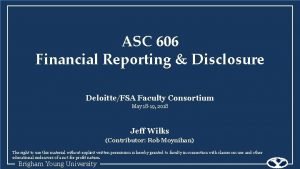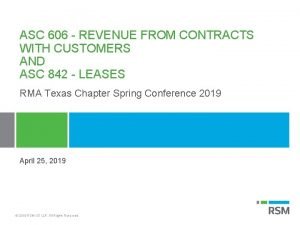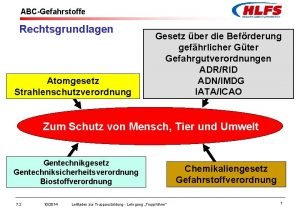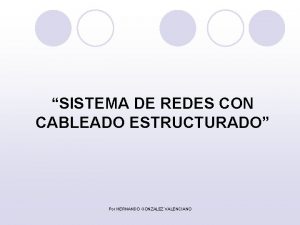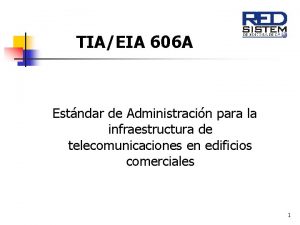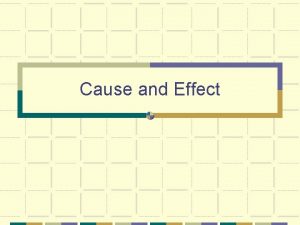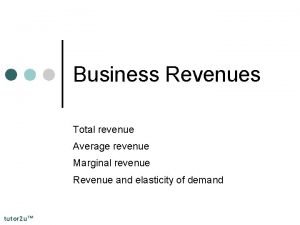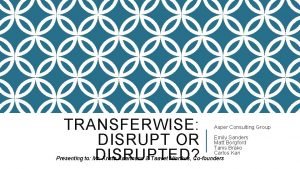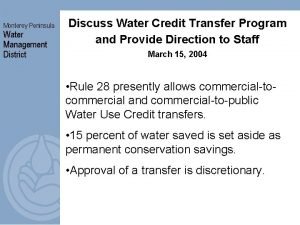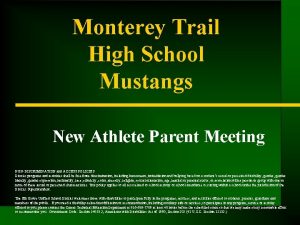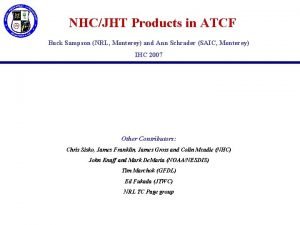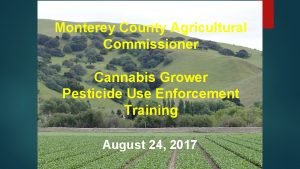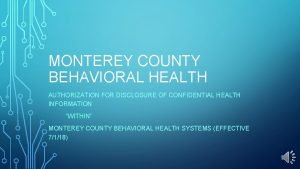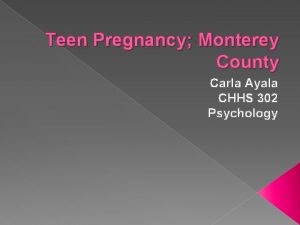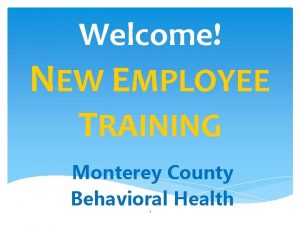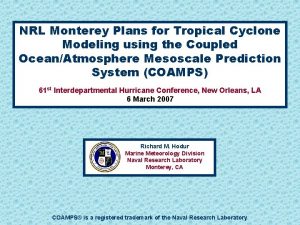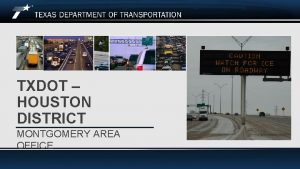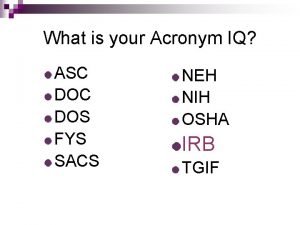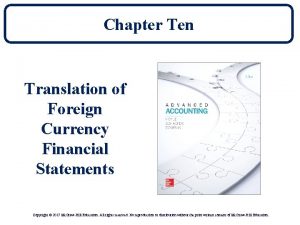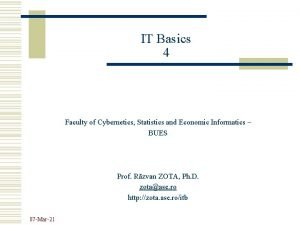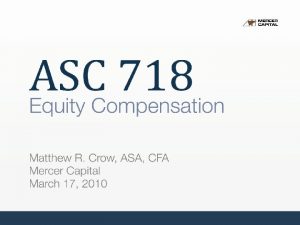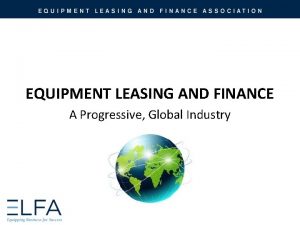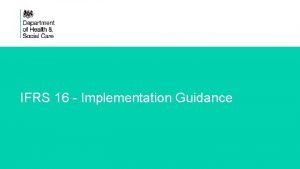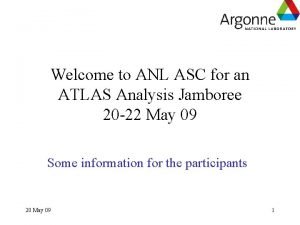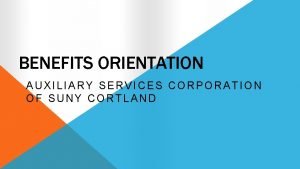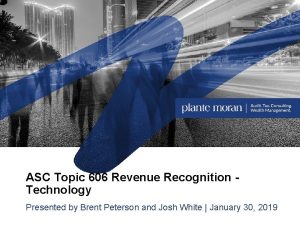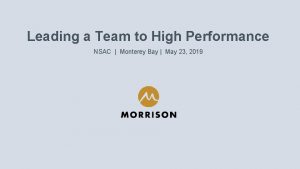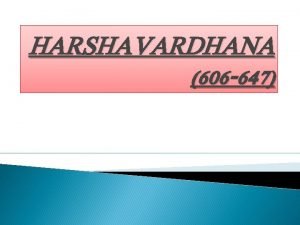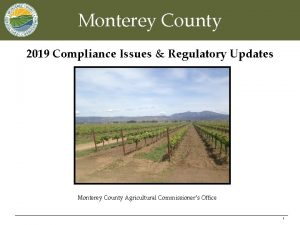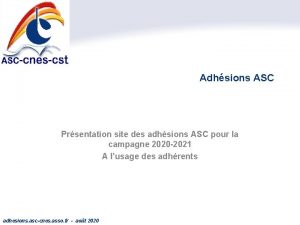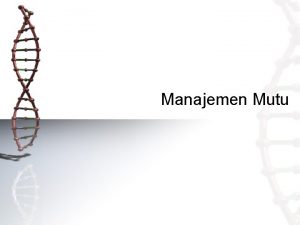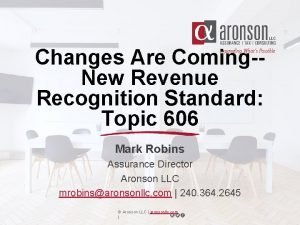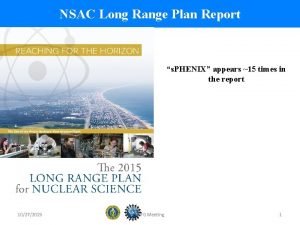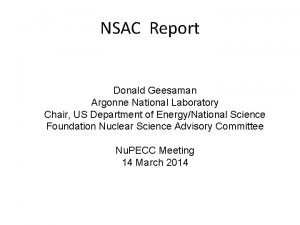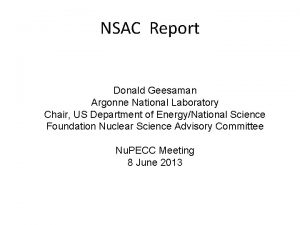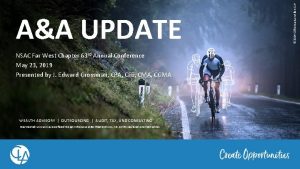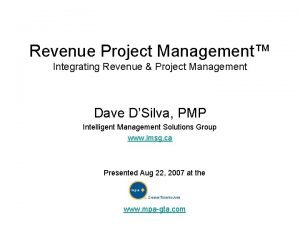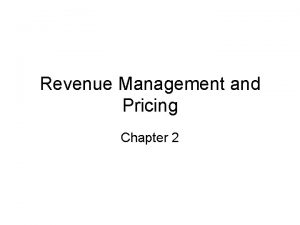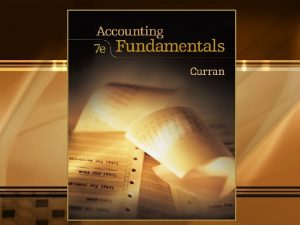NSAC 2019 Monterey CA ASC 606 Revenue from

































- Slides: 33

NSAC 2019 – Monterey, CA ASC 606 Revenue from Contracts with Customers May 23, 2019 K-deep Dhaliwal, Partner for Moss Adams LLP

Agenda 1. 2. 3. 4. 2 Overview of ASC 606 Revenue from Contracts with Customers Five-Step Approach Effective Dates & Transition Implementation Strategy

Why did we need a new Revenue Recognition Standard? • GAAP had over 200 separate pieces of guidance on how to recognize revenue • Industry specific guidance was producing inconsistent results for economically similar transactions • Software licensing • Construction • Technology • Guidance was voluminous, fragmented and complex • Old GAAP – realized or realizable

Overview of ASC 606 Revenue from Contracts with Customers Five-Step Process

Five-Step Process 5

Five-Step Approach

Step 1: Identify the Contract • Contract: an agreement that creates enforceable rights and obligations • Criteria o Approval and commitment of the parties – written or oral o Identification of rights and payment terms – matter of law 7 o Commercial substance – amount of future cash flow is expected to change o Collectability is probable at inception – customer’s ability to pay

Step 2: Identify Performance Obligations • Performance obligation: a promise in a contract to transfer a good or service • This step will require most of the analysis • Criteria o Distinct good or service 8 o Series of substantially similar distinct goods or services that have the same pattern of transfer

Step 2: Identify Performance Obligations • A good or service is distinct if both criteria are met: 1. Benefits the customer on its own 9 2. Separately identifiable from other promises o Isn’t used as an input to produce a combined output • Contract to build a building would likely be treated as one distinct performance obligation. Although there are many inputs and unique services/goods that are performed (demolition, foundation, framing, finish) each phase of construction is intended to produce one combined output – the office building. o Isn’t highly dependent or interrelated with other goods or services in the contract

Example - Slotting Fees/Pay to play • Manufacturers of consumer products commonly pay retailers fees to have their goods displayed prominently on store shelves (‘slotting fees’), or will pay an up-front fee to customer to obtain a new contract (‘pay to play’) 10 Current GAAP (ASC 605): Amounts generally reduce revenue

Example - Slotting Fees/Pay to play (cont. ) New GAAP (ASC 606): Such slotting or pay to play fees do not provide a distinct good or service to the manufacturer (step 2) as the manufacturer cannot sell the slotting fees separately, and would not obtain any rights or receive benefits without selling products to the retailer. The slotting fee should be treated as a reduction of the transaction price. 11

Step 3: Determine Transaction Price • Transaction price: amount of consideration which an entity expects to be entitled in exchange for transferring goods or services • Complex areas: o Variable consideration and related constraints 12 o Right of return

Step 3: Determine Transaction Price • Variable consideration - The transaction price might include an element of consideration that is variable or contingent on the outcome of future events, including (but not limited to): o Discounts, rebates, coupons, price concessions, refunds, returns, credits, incentives, performance bonuses, and royalties. 13 • Two methods for estimation: o Most likely amount o Expected Value

Step 3: Determine Transaction Price • Variable consideration is included in the transaction price to the extent it is probable that there will not be a significant reversal in the amount of cumulative revenue recognized o Consider likelihood and magnitude in determining constraints 14 • Estimated transaction price is reassessed at the end of each reporting period through end of contract

Example #1 - Volume Discounts • Manufacturers may provide incentives to their customers through volume discounts. These discounts can take different forms, such as tiered pricing (e. g. , discounted pricing on future purchases over a certain volume level) or a discount that applies to all purchases under the agreement (e. g. , discounted pricing on a retrospective basis once a certain volume level is met). 15 Current GAAP (ASC 605): Sales incentives offered to customers are typically recorded as a reduction of revenue at the later of the date at which the related sale is recorded by the vendor or the date at which the sales incentive is offered.

Example #1 - Volume Discounts (cont. ) New GAAP (ASC 606): Prospective discount (i. e. tiered pricing) - Generally, if a volume rebate or discount is applied prospectively, the rebate or discount would be accounted for as a customer option (not variable consideration). This is because the consideration for the goods or services in the present contract is not contingent upon or affected by any future purchases. Rather, the discounts available from the rebate program affect the price of future purchases. 16 Retrospective discount (i. e. discount applied once volume is met) – Generally, a volume rebate or discount that is applied retrospectively will be accounted for as variable consideration. This is because the final price of each good or service sold depends on the customer’s total purchases subject to the rebate program. That is, the consideration is contingent upon the occurrence or nonoccurrence of future events. Entities will need to evaluate whether the volume rebate or discount provides the customer with an option to purchase goods or services in the future at a discount that represents a material right (and is therefore accounted for as a performance obligation).

Example #2 - Demonstrations In-store demonstrations could be included in a contract which requires consideration payable to a customer. Current GAAP (ASC 605): Sales incentives offered to customers are typically recorded as a reduction of revenue at the later of the date at which the related sale is recorded by the vendor or the date at which the sales incentive is offered. 17 New GAAP (ASC 606): An entity needs to determine the transaction price, which is the amount of consideration it expects to be entitled to in exchange for transferring promised goods or services to a customer. Consideration payable by an entity to a customer is accounted for as a reduction of the transaction price unless the payment is for a distinct good or service that the customer transfers to the entity.

Example # 3 - Rights of Return Current GAAP (ASC 605): Revenue is recognized at the time of sale if future returns can be reasonably estimated. Returns are estimated based on historical experience with an allowance recorded against sales. Revenue is not recognized until the return right lapses if an entity is unable to estimate potential returns. New GAAP (ASC 606): Entities will recognize the amount of consideration received or receivable that is expected to be returned as a refund liability, representing their obligation to return the customer’s consideration. 18 Entities will also recognize a return asset (and adjust cost of sales) for the right to recover the goods returned by the customer. They will initially measure this asset at the former carrying amount of the inventory, less any expected costs to recover the goods, including potential decreases in value of the goods expected to be returned. At each reporting date, they will remeasure the refund liability and update the measurement of the asset recorded for any revisions to the expected level of returns, as well as any additional decreases in the value of the products expected to be returned. Presentation - The standard requires the carrying value of the return asset to be presented separately from inventory and subject to impairment testing on its own, separately from inventory on hand. The standard also requires the refund liability to be presented separately from the corresponding asset (on a gross basis rather than a net basis).

Example # 3 - Rights of Return (cont. ) Assume Apparel Co. offers its customers the right to return any products purchased up to 30 days after sale, for any reason. Last Tuesday, Apparel Co. sold 100 red sweaters to different customers. Based on historical experience, Apparel Co. expects 15 of those sweaters to be returned for a full refund. Each sweater sells for $80 and costs Apparel $35 to produce. 19 Apparel Co. would record the following journal entries for the sale of the sweaters and the expected refund liability and corresponding asset. Cash

Step 4: Allocate the Transaction Price • Allocate the transaction price to each performance obligation based on a relative standalone selling price basis • One performance obligation – simple • Multiple performance obligations – more complex 20

Step 4: Allocate the Transaction Price 21 • Standalone selling price is the price at which the entity would sell a good or service to a customer • Doesn’t require the good or service to actually be sold • Best evidence of standalone selling price is the observable price of a good or service sold separately

Step 4: Allocate the Transaction Price • If no observable sales, estimate standalone selling price based on the following methods: • Top-down approach • • Bottom-up approach • 22 Adjusted market assessment Expected cost plus a margin

Step 5: Recognize the Revenue • An entity recognizes revenue when (or as) the entity satisfies a performance obligation by transferring the goods or services to a customer • An asset (good or service) is considered transferred when (or as) the customer obtains control of the asset 23

Step 5: Recognize the Revenue • Recognize revenue when or as a performance obligation is satisfied • Two methods: o At a point in time o Over time 24

Step 5: Recognize the Revenue • Revenue is recognized over time if: o The customer simultaneously receives and consumes the benefits as the entity performs; or o The entity’s performance creates or enhances an asset that the customer controls; or 25 o The entity’s performance doesn’t create an asset with an alternative use to the entity and enforceable right to payment exists.

Five-Step Process – Summary 26

Effective Dates & Transition

Effective Dates • Public Entities o Effective date - periods beginning after 12/15/17 o Early adoption beginning after 12/15/16 • Nonpublic Entities 28 o Effective date - periods beginning after 12/15/18 o Early adoption permitted up to the public entity early adoption date

Transition – Full Retrospective • Retrospective to each prior period reported with practical expedients: o Completed contracts that begin and end in the same annual reporting period do not need to be restated o Completed contracts with variable consideration, can use the transaction price at the completed contract date o For reporting periods prior to initial adoption don’t need to disclose the portion of the transaction price allocated to the remaining performance obligation 29 • Disclose prior-period information that has been adjusted

Transition – Modified Retrospective • Retrospectively with the cumulative effect recognized at the date of initial application. Any necessary adjustments would be recorded to opening retained earnings on the date of adoption—prior periods wouldn’t be restated. 30 • This would involve comparing how those contracts would have been recorded under Topic 606 with how they were actually recorded under legacy GAAP. • Must provide additional disclosure in the reporting period of initial application o Disclose effects of adoption on each FS line item o Explanation for the reasons for any significant changes in financial reporting based on the new standard

Implementation Strategy

Implementation Strategy PHASE I – INITIAL ASSESSMENT Step 1 – Familiarize yourself with the standard Step 2 – Perform high level assessment - discuss gray areas with Moss Adams Step 3 – Document high level impact/summary PHASE II – PLANNING 32 Step 4 – Detailed plan – timeline, resources, budget, transition approach Step 5 – Controls & systems impact – Reports, tools, templates PHASE III – IMPLEMENTATION Step 6 – Document accounting processes/controls Step 7 – Perform contract analysis/data aggregation Step 8 – Document technical accounting memos & financial statement disclosures

The material appearing in this presentation is for informational purposes only and should not be construed as advice of any kind, including, without limitation, legal, accounting, or investment advice. This information is not intended to create, and receipt does not constitute, a legal relationship, including, but not limited to, an accountant-client relationship. Although this information may have been prepared by professionals, it should not be used as a substitute for professional services. If legal, accounting, investment, or other professional advice is required, the services of a professional should be sought. 33 Assurance, tax, and consulting offered through Moss Adams LLP. Wealth management offered through Moss Adams Wealth Advisors LLC. Investment banking offered through Moss Adams Capital LLC.
 Deloitte asc 606 guide
Deloitte asc 606 guide Asc 606 short term lease
Asc 606 short term lease Asc 340-40-25-1
Asc 340-40-25-1 Munitionsbrandklassen
Munitionsbrandklassen Ansi/tia/eia-606-a
Ansi/tia/eia-606-a Eia 606
Eia 606 Artigo 606 cpc
Artigo 606 cpc Tia/eia 606-a
Tia/eia 606-a Honda commercial 606 takes
Honda commercial 606 takes Regulamentul 606/2013
Regulamentul 606/2013 Total revenue
Total revenue Asper consulting
Asper consulting Monterey peninsula water management district
Monterey peninsula water management district Cif eligibility rules gpa
Cif eligibility rules gpa Monterey festival janis joplin
Monterey festival janis joplin Nrl monterey
Nrl monterey Monterey county agricultural commissioner
Monterey county agricultural commissioner Monterey county behavioral health
Monterey county behavioral health Teen challenge monterey bay
Teen challenge monterey bay Monterey county behavioral health
Monterey county behavioral health Freddie mac towing
Freddie mac towing Nrl monterey tropical
Nrl monterey tropical Monterey bus boycott
Monterey bus boycott Irb acronym
Irb acronym Kim fleck
Kim fleck Asc 830
Asc 830 Academic success center tamu
Academic success center tamu Faculty of cybernetics statistics and economic informatics
Faculty of cybernetics statistics and economic informatics Asc 718
Asc 718 Operating lease
Operating lease Stress breaker in fpd
Stress breaker in fpd Sale and leaseback ifrs 16
Sale and leaseback ifrs 16 Atlas asc
Atlas asc Suny oswego auxiliary services
Suny oswego auxiliary services
